The organic way of life is slowly becoming less of a passing trend and more of a lifestyle, for an increasingly number of people.
Non-violence in the garden
Towards the end of the 1980s, a gentle revolution was emerging. The revolution, however, wasn’t concerned with overthrowing an old order but rather in reviving an old tradition. Judith Chase, an American citizen, started an organic farm here in 1987. “She just wanted a small garden,” Jim, her husband, told me. “Within a year, we had a hundred people working that garden.” Judith didn’t start out thinking she’d be known as the pioneer of organic farming in Nepal, or, as one farmer referred to her, the “mother of Nepal’s organic farming”. “Perhaps I used the word organic in the Nepali market for the first time, but organic farming has been around since the beginning of time,” she told me, eager to shrug off the credit for initiating organic farming in Nepal.
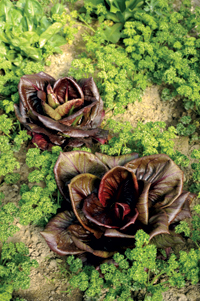
The rich colors of the organic vegetables do justice to the nutritional value of the organic products
Judith and Jim moved to Gamcha Gaon, Dadhikot in June 1987. “One of my gardening friends from California came to Nepal to go on pilgrimage to Mount Kailash. She had brought many packets of vegetable seeds from Italy as gifts. I planted them all and eventually had an extensive and diverse garden, including many new-to-Nepal varieties such as artichokes, Brussels sprouts, arugula, salad blends and leeks. Mike Frame, the owner of Mike’s Breakfast, offered to buy all the extra artichokes and salad greens. I proposed holding a small weekly market within his courtyard,” she recalls. It was an instant hit. Expatriates liked the variety of vegetables as well as the fact that they weren’t washed in the local rivers.
Eventually, she started a larger twice-weekly market at the Summit Hotel, which still continues today, although under different management. “In order to supply the increasing demands and to offer an income generating opportunity to our community, I invited neighbors to participate in bio-intensive training,” Judith says. In the beginning, thirteen people enrolled for her training program. The program became popular, and was extended. The participants grew to number160, most of whom were women.
Today, many of those women continue to grow vegetables for the Kathmandu market. Judith told me that their produce is about to be certified as organic. After she left the farm and returned to the US, Ramesh Khadka, a local farmer, took over. Today, he runs Appropriate Agricultural Alternatives (AAA), the NGO that Judith set up, and works with 46 local women farmers. Besides buying these women’s produce, Ramesh’s organization trains them. He took me around the village and whenever we reached a farmer’s house he’d head straight for the garden. Then he’d advise them on how to improve their plants’ quality, suggest planting more profitable crops, and encourage them to grow more. I watched him at his office, where in the evening women came carrying baskets of vegetables. Bantering and counting, Ramesh sorted the vegetables onto a large tarpaulin sheet. The women bring their vegetables four times a week and leave with a slip of paper recording their day’s sale.
Organic farming has changed the lives of these women. “We make more money than we used to. Since we grow vegetables the labor required is considerably less as compared to corn. I am economically independent. I don’t have to ask my husband for money,” says Sabitri Khadka. Another woman, who has been farming organically for around eighteen years, told me she is now able to give her children money for their bus fare to school and for snacks. Sukundhara Khadka, who switched to organic farming recently, made 20,000 rupees in a single season by selling avocados. Since most women cultivate small patches of land, usually their gardens, they can devote time and effort without disrupting their household chores. All the women that came to Ramesh to sell their produce told me that they now have money to spend at the end of the month. “The vegetables in my garden taste better now. Also, I save the money I used to spend on chemical fertilizers and pesticides,” says Roshana Thapa.
Ramesh is the link between Gamcha’s organic produce and the market in Kathmandu. His reasons for opting for organic farming are, however, not founded on the idea of running a profitable business. “Organic farming is not only about eating and selling. It’s about teaching your neighbors that they too can grow organically, that they can grow a large variety of vegetables in their own gardens. They don’t need to buy,” he told me.
Lis Rasmussen, who has been farming organically in her native Denmark for over 40 years, seconds the idea of one person influencing another to grow organically. She is the project coordinator at Gamcha Organic Farm, which is run by Sobogaard, a Danish company. It is sponsoring the organic certification of the 46 women farmers. She considers organic farming a responsible practice. “Organic farming keeps the soil healthy. You take care of the soil. People need to start thinking about aspects of their food like taste and how it’s grown. There needs to be a sense of responsibility towards the world,” she said. She laments how Nepal has changed in the 40 years since she first visited it. “You can’t imagine how clean Nepal was. If things continue in the same manner as now, soon there’ll be no tourists.”
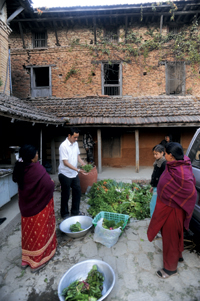
Ramesh Khadka’s ngo collects organic products from yhe villagers before taking them to kathmandu’s various organic vegetable vendors
Purity lost
A sense of loss is often the corollary to a discussion on organic farming. Rishikesh Tiwari, a farmer from the Parbat district who calls himself a “social activist and entrepreneur”, remembers his grandmother’s rich garden. “Even after our family, which consisted of over 20 people, was fed and vegetables were sent to relatives, my grandmother still couldn’t use up all the vegetables from her garden. She used to feed them to our cows. Her garden was completely organic,” he says. Then, he remembers the advent of chemical fertilizers. “The soil, which was loose and rich earlier, became hard. Earthworms vanished. Chemicals killed the farmer’s friends.” He also considers his father’s exposure to chemicals as the reason for his developing cancer and ultimately dying of it.
Organic farming is based on traditional knowledge. Govinda Sharma, a PhD student in organic farming, says a farmer that cultivates organically is his own master. “In organic farming, a farmer uses the knowledge that he has. He doesn’t need to depend on shops selling chemical fertilizers and pesticides,” he says.
But ever since the practice of using chemicals in agriculture overtook the traditional form in Nepal half a century ago, organic farming became not only unpopular but a target of derision. Humiliation wasn’t uncommon for the advocates of organic farming. It was a joke in the rooms of government offices concerned with agriculture. “People used to laugh when we talked about organic farming,” says Lakpi Lama, a trainer in organic farming. Farmers turned a deaf ear to her when she went around trying to espouse the benefits of organic farming. “Organic food is for Westerners, not for Nepalis,” they’d tell her.
Based on his experience of rural Nepal, which he gained during his days as a political activist, Tiwari came up with a formula to combat poverty in the villages. He helped establish Parbat Community Development Society in 1994. The organization’s approach to development was based on the philosophy of ‘working from where one is, working with what one has and with how much one has’. Today, the organization helps villagers to produce and sell organic goods. It manufactures a total of 15 organic products, including pickle, jam, and candy made from lapsi, coffee, and a variety of vegetables. They also manufacture organic fertilizers and pesticides from banmara (forest killer), a shrub that, if unchecked, kills trees. The Dalit community has specifically benefitted from this product since they were landless and so couldn’t grow vegetables. Tiwari convinced a number of people to farm organically instead of taking loans and going abroad for employment. “Organic farming has put a smile on many dour faces in my village. It has changed lives. This can happen anywhere in Nepal. People don’t realize that organic farming can be a lucrative profession. It has the potential to become a huge market,” he says.
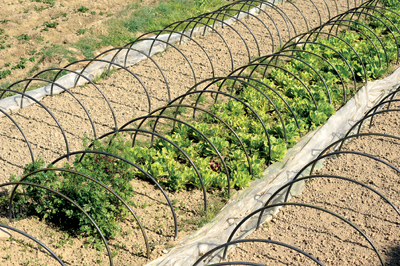
Carefully manicured farms in sanga
Prem Lama is aware of the potential of organic farming in Nepal. He exports organic vegetables to Singapore every week. The demand for Nepal’s organic produce is immense, he tells me. “Some of the gulf countries want two containers of organic vegetables every week. But we’re not producing on that kind of a scale at the moment. Entire villages and districts should turn organic,” he says.
Reviving a tradition and keeping the land alive
Since most of us haven’t seen the old style of farming with its compost pits, manure, and seemingly archaic tools, we believe organic farming is a new approach. Use of machinery and chemicals is considered the best way to increase yield and improve the farmer’s life. Lama believes machine and chemicals have needlessly complicated agriculture. “If you plant seasonal crops, you don’t need chemicals and pesticides,” he said.
Traditional farming practices were based on an ancient wisdom, much of which has been lost or lives on only in the memories of old farmers. “Cow’s urine – a cow fed on organic fodder – has been used since ages as a disinfectant. Why do you think the cow is considered holy?” Tiwari asks rhetorically. He lamented that people ignored the fact that cow urine is an excellent pesticide and just let it drain away. A farmer in Kavre told me that during his father’s time farmers used to beat a local plant near streams that flowed into their fields. The plant’s juice, which is an effective insecticide, mixed with the water and thus got to the crops. The fiber from the battered plants was used in making ropes.
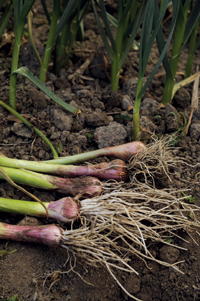 The old wisdom, however, does not appeal to Nepali farmers, who are bent on increasing production. This has led to the use of chemical fertilizers, hybrid seeds, and other malpractices that have robbed the land of its purity and productivity. Older and better varieties of crops have been dwarfed by newer and bigger ones. “I am 56 years old. I still remember the taste of organic food. When my grandmother used to cut a cucumber its scent used to fill the entire house. Where is that scent now?” Tiwari asks, looking into the distance as if expecting to catch a whiff of that old smell. The indigenous crop varieties were not just aromatic. The anadi, an indigenous rice variety, is known to cure body ache and benefit pregnant women. Another variety, the aanga, grows well even with little water. “These indigenous seeds are our future. They make the farmer independent. He doesn’t need to invest in seeds,” says Tiwari. But both these varieties are on the verge of disappearing. Tiwari has created seed banks to preserve such indigenous varieties. The small garlic, which is potent and spicy, has almost vanished from Kathmandu’s vegetable markets, and has been supplanted everywhere by the larger but insipid variety.
The old wisdom, however, does not appeal to Nepali farmers, who are bent on increasing production. This has led to the use of chemical fertilizers, hybrid seeds, and other malpractices that have robbed the land of its purity and productivity. Older and better varieties of crops have been dwarfed by newer and bigger ones. “I am 56 years old. I still remember the taste of organic food. When my grandmother used to cut a cucumber its scent used to fill the entire house. Where is that scent now?” Tiwari asks, looking into the distance as if expecting to catch a whiff of that old smell. The indigenous crop varieties were not just aromatic. The anadi, an indigenous rice variety, is known to cure body ache and benefit pregnant women. Another variety, the aanga, grows well even with little water. “These indigenous seeds are our future. They make the farmer independent. He doesn’t need to invest in seeds,” says Tiwari. But both these varieties are on the verge of disappearing. Tiwari has created seed banks to preserve such indigenous varieties. The small garlic, which is potent and spicy, has almost vanished from Kathmandu’s vegetable markets, and has been supplanted everywhere by the larger but insipid variety.
But size is no guarantee of an increase in agricultural yield. “Hybrid corn, when ground into flour, yields a lesser amount in comparison to the yield from the same quantity of indigenous corn,” says Raja Ram Poudel, a farmer in Sankhu. Raja Ram is the manager at Sankhu Palubari Cooperative Organization, which has been promoting organic farming in the Palubari and VisambharaVDCs for the past five years. The cooperative was started with a view to raising the income of less privileged sections of the community. The community school, which most of the children from poor families attend, was in need of funds. Krishna Raj Subedi, a local farmer, came up with the idea of a cooperative to generate those funds. He is now the chairman of the cooperative. “Farmers here were dependent on chemical fertilizers and insecticides. People used to fall sick all the time,” he says.
Subedi and a few other villagers decided to raise awareness about the hazards of using chemicals in farming. They motivated people to give up using chemicals in their gardens. But people were skeptical. “When we first approached people with this idea they said, ‘You want to push us back to our fathers’ time, when they didn’t use chemicals and starved?” Subedi recalls. One of the most common beliefs regarding organic farming is that it’s not as productive as using chemicals. “It takes a minimum of three years for land that was previously farmed using chemicals to become organic again. But once it is organic, it yields as much as when chemicals were used,” says Subedi. To anyone that doubts the ability of organic farming to produce as much as conventional farming, Tiwari offers the story of his grandmother’s bountiful organic garden as proof.
 Those intermediate three years are the biggest deterrent to farmers switching to organic. Nobody wants to wait that long for returns. Poudel and Subedi, both experienced farmers, believe it’s worth the wait. They say chemicals are a short-term remedy and that they do more harm than good in the future. “Chemicals result in a decline in soil fertility. There are several health hazards of eating food grown by using chemicals,” says Subedi. He says that organic farming is more economic as it reduces the risks to people’s health, thus cutting on medical expenses. Secondly, organic farming means farmers don’t have to buy expensive chemicals. The cooperative hopes to turn all of the 663 households in the two VDCs in which it works organic. Members sell their produce to Kathmandu and their income levels have risen.They are also healthier than before. One of their slogans, - ‘Going organic from school to home’ - has resulted in children taking over the role of educators and monitors. “There have been instances when children have turned up to school on empty stomachs. They had refused to eat their meals because the parents had used chemicals in the family garden,” says Subedi.
Those intermediate three years are the biggest deterrent to farmers switching to organic. Nobody wants to wait that long for returns. Poudel and Subedi, both experienced farmers, believe it’s worth the wait. They say chemicals are a short-term remedy and that they do more harm than good in the future. “Chemicals result in a decline in soil fertility. There are several health hazards of eating food grown by using chemicals,” says Subedi. He says that organic farming is more economic as it reduces the risks to people’s health, thus cutting on medical expenses. Secondly, organic farming means farmers don’t have to buy expensive chemicals. The cooperative hopes to turn all of the 663 households in the two VDCs in which it works organic. Members sell their produce to Kathmandu and their income levels have risen.They are also healthier than before. One of their slogans, - ‘Going organic from school to home’ - has resulted in children taking over the role of educators and monitors. “There have been instances when children have turned up to school on empty stomachs. They had refused to eat their meals because the parents had used chemicals in the family garden,” says Subedi.
Let live, grow more
The need to use chemicals in agriculture can be compared to an alcoholic’s need for alcohol: it becomes progressive and ultimately gets out of hand. “I learned from my experience of using pesticides that the quantity required increased every year,” says Poudel. Lakpi Lama remembers the importance given to chemicals in technical courses on farming. She studied for three years to become a Junior Technical Assistant (JTA). “There were twenty to twenty-five names of chemicals you had to know. If you didn’t know them, you wouldn’t pass the exams,” she says. Nepali farmers, Subedi says, have a penchant for chemicals. “It’s a habit of a Nepali farmer to go to a shop selling chemical fertilizers and insecticides and ask for the most potent ones. Most of those chemicals were banned by the government a decade ago,” he says.
The solution to the problems ravaging a garden are, Subedi believes, in the garden itself, not in the shops selling chemicals and insecticides. He told me the best alternative to insecticides was in our gardens. “We have been using a solution made my mixing ginger, garlic and chilies as insecticide on our crops. It repels insects against which insecticides are ineffective,” he claims proudly.
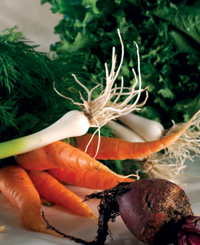 It was his belief in non-violence that attracted Govinda Sharma to organic farming. “I believe every creature deserves our compassion equally. If I consider slaughtering a goat a sin, why should I kill a grasshopper? This is why I chose organic farming,” he says. Sharma runs Hasera Agriculture Research and Training Center in Patlekhet, Kavre. He told me that organic farming was the ideal method for farming. According to him, organic farming provides plants with all the nutrients they need. Chemicals only produce half of more than 70 of these nutrients. Chemical farming kills certain organisms. Organic farming is not a killer and thus preserves bio-diversity. Sharma believes crops yield according to what they are fed. “Nowadays, the tomatoes that have been grown using chemicals look red and plump. But they’re not as sour as they ought to be. If you make tomato chutney, you’ve to add lime,” he says.
It was his belief in non-violence that attracted Govinda Sharma to organic farming. “I believe every creature deserves our compassion equally. If I consider slaughtering a goat a sin, why should I kill a grasshopper? This is why I chose organic farming,” he says. Sharma runs Hasera Agriculture Research and Training Center in Patlekhet, Kavre. He told me that organic farming was the ideal method for farming. According to him, organic farming provides plants with all the nutrients they need. Chemicals only produce half of more than 70 of these nutrients. Chemical farming kills certain organisms. Organic farming is not a killer and thus preserves bio-diversity. Sharma believes crops yield according to what they are fed. “Nowadays, the tomatoes that have been grown using chemicals look red and plump. But they’re not as sour as they ought to be. If you make tomato chutney, you’ve to add lime,” he says.
Judith, who returned to Nepal two years ago, practices bio-intensive farming on her farm, which is aptly named Everything Organic, in Patlekhet. Her approach to farming has been influenced by John Jeavons, an American farmer and researcher who has been researching on bio-intensive agriculture for decades. “This is our Gita,” she said as she handed me Jeavons’ book, entitled ‘How To Grow More Vegetables’. Then she opened to a page where there were numerous columns. Each carried information on various aspects of a particular plant. On the last column was the average maximum yield of a particular plant in a given area of land using chemicals. When compared to the minimum yield of the same plant grown bio-intensively on the same amount of land, the maximum yield of chemically grown plants was consistently lower for every plant.
John Jeavons and his research team at Ecology Action have shown that yields can increase from four to six times the average US yield. “Bio-intensive farming is ideal for Nepal, because the land holdings here are sometimes quite small. Besides, the farmers are talented workers. By increasing production using Nepali bio-intensive processes and by introducing new varieties of vegetables, fruits and nuts to expand farmers’ incomes, Nepali agriculture can contribute more to the country’s economy,” says Judith. She hopes to make farming a prestigious occupation. “The diversity of ecosystems within Nepal can provide a great range of valuable crops, bringing deserved appreciation and respect to this ancient occupation.”
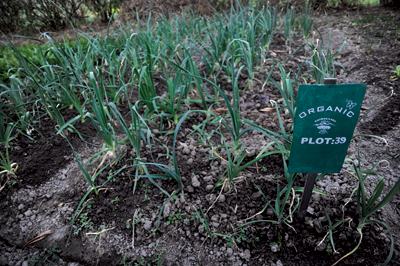
Everything organic ‘s well managed plot in patlekhet
Govinda Sharma sees the possibility for Nepal to create a niche for its organic produce in the global market. He says that Nepal cannot compete globally with countries that practice mechanized and chemical farming. “Organic farming is the sector we should target. Our country can earn money by exporting organic food,” he says. Sharma sees organic farming not merely as a means to earning foreign currency but as a tool for social and economic empowerment. “Since organic farming is based on traditional knowledge, its growth ultimately leads to an improvement in the lives of those who practice it. In the case of our country, this means women. Organic farming works well in remote areas, since most remote areas have retained, due to lack of development, traditional methods of agriculture. One only needs to tell the farmers in these areas the value of their produce to empower them. Awareness on organic farming inevitably helps identify products that may be hidden from the markets.”
The use of chemicals in farming is a relatively new trend in Nepal. Fortunately, many parts of Nepal remain unscathed by their ruinous touch. This makes it easier to return to organic farming, leaving the soil to the earthworms and to Nature’s innumerable workers that maintain purity. “We’ve had enough revolutions already. Now Nepal needs an organic revolution,” declares Tiwari. It is a desirable revolution. Organic farming keeps us healthy. It also keeps the environment healthy. It keeps the garlic hot. And it makes all this possible without hurting the grasshopper. As Jim said, “Ahimsa is the foundation of organic farming.”
If you want to practice ahimsa in your own gardens and want to learn how to do it, Judith Chase runs a short training session on bio-intensive farming methods every Saturday at 11 a.m. in her farm in Kavre. She can be reached at judithconantchase@gmail.com.For additional information: Govinda Sharma(govindasharmma@yahoo.co.uk), Krishna Raj Subedi (poudyaldr@hotmail.com), Prem Lama (prem@wlink.com.np), Rishikesh Tiwari (rishi_tiwari54@ hotmail.com), Ramesh Khadka (khadkagaurav@gmail.com)










